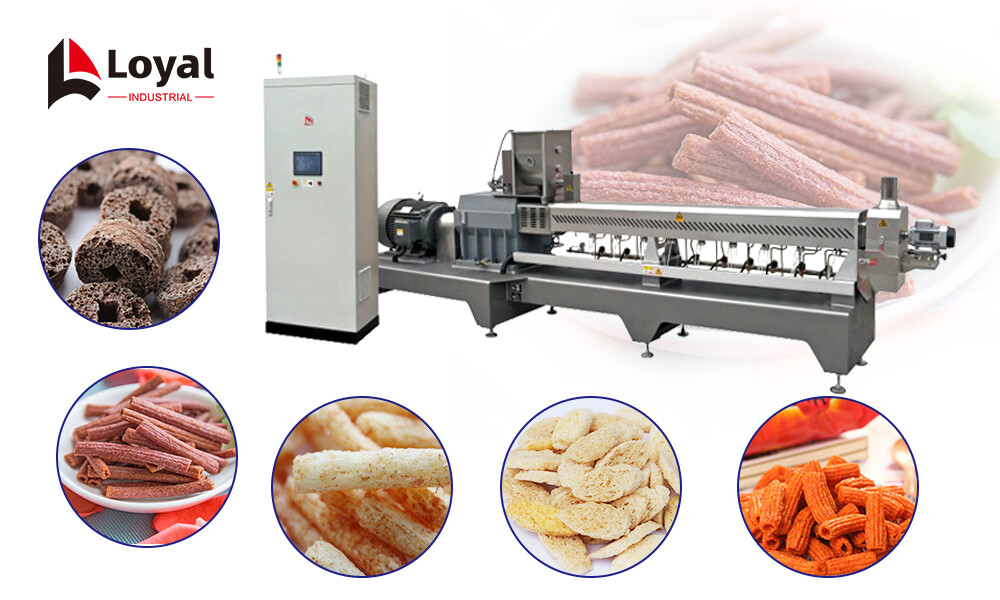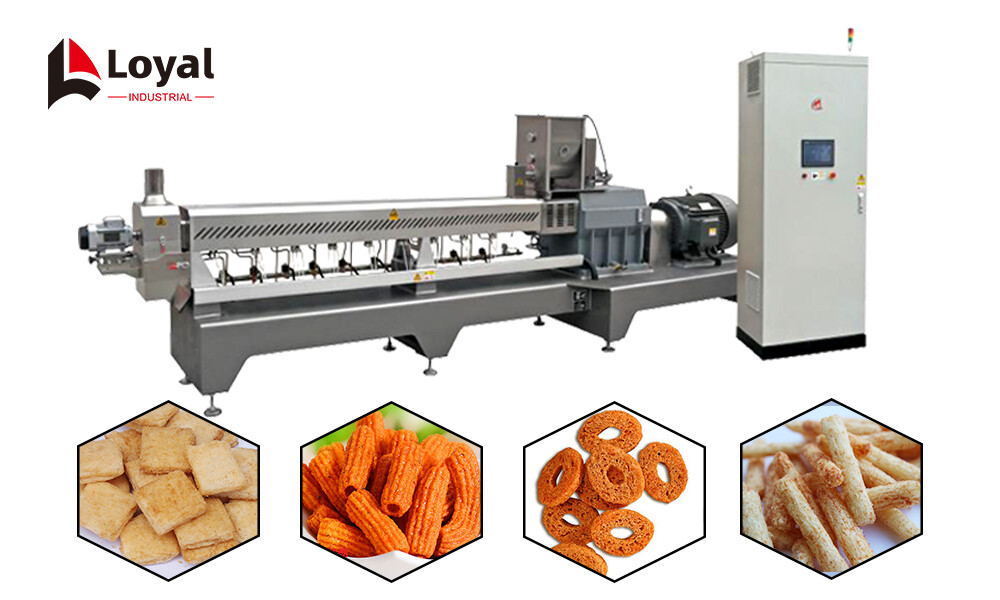The Ultimate Guide ToExtruded snack production line Updated 2025
Streamline Raw Material Preparation
Efficiency in extruded snack production lines begins long before the extrusion process itself. Raw material preparation is a critical yet often overlooked stage that directly impacts product consistency, equipment performance, and operational costs. Here’s how to optimize this phase for maximum throughput and quality.
1. Select High-Quality Ingredients
The foundation of efficient extrusion lies in ingredient selection.
- Starch sources (corn, wheat, rice) should have uniform particle size and moisture content (ideally 12–14%) to ensure smooth flow through the extruder.
- Protein-rich ingredients (soy, pea) require pre-testing for solubility to prevent clogging.
- Additives (emulsifiers, stabilizers) must be food-grade and compatible with your extruded snack production line’s shear and temperature profile.
2. Pre-Conditioning for Uniform Dough
Pre-conditioning blends raw materials with water/steam to achieve optimal plasticity before extrusion.
- Ideal moisture levels (18–25%) reduce extruder motor load by up to 15%.
- Twin-shaft mixers ensure homogeneous hydration, preventing dry pockets that cause uneven expansion.
- Retention time (3–5 minutes) allows complete starch gelatinization for consistent texture.
3. Reduce Moisture Variability
Moisture inconsistency is a leading cause of production downtime.
- Inline NIR sensors monitor moisture content (±0.5% accuracy) and auto-adjust water injection.
- Closed-loop systems recycle steam from the dryer to pre-heat ingredients, saving energy.
- Storage silos with climate control maintain raw material stability in humid environments.
4. Particle Size Optimization
- Fine grinding (<500 microns) improves expansion ratios but increases extruder wear.
- Granulation analysis (via laser diffraction) identifies ideal particle distribution for your extruded snack production line’s screw design.
- Screening systems remove oversized particles that could jam the extruder feed section.
5. Material Handling Efficiency
- Pneumatic conveyors minimize starch damage compared to mechanical screw feeders.
- Load cells in hoppers ensure precise batch weights, reducing recipe deviations.
- Dedicated lines for allergen/non-allergen ingredients prevent cross-contamination.

Minimize Downtime & Maintenance
In the highly competitive snack food industry, optimizing your extruded snack production line is essential for achieving maximum efficiency, reducing costs, and maintaining high-quality product output. One of the most critical aspects of this optimization process is minimizing downtime and ensuring effective maintenance. An Extruded Snack Production Line consists of several integrated machines and processes that work together to transform raw ingredients into delicious, ready-to-eat snacks. By focusing on minimizing downtime and implementing a robust maintenance strategy, manufacturers can significantly enhance their production capabilities and overall profitability.
1.Understanding Downtime in Extruded Snack Production
Downtime in an extruded snack production line refers to any period during which the machinery is not operational due to maintenance, repairs, or unexpected breakdowns. This can occur for various reasons, including mechanical failures, electrical issues, or operator errors. Minimizing downtime is crucial because it directly impacts production output and, consequently, revenue. Even short periods of downtime can lead to significant losses, especially in high-volume production environments.
To effectively minimize downtime, it is essential to understand the root causes of production interruptions. Common culprits include worn-out parts, inadequate lubrication, and improper calibration of equipment. By identifying these issues early, manufacturers can take proactive measures to prevent them from escalating into more significant problems that require extended downtime.
2.Implementing a Preventive Maintenance Program
One of the most effective ways to minimize downtime is by implementing a comprehensive preventive maintenance program. This involves regular inspections, cleaning, and replacement of worn-out parts before they cause breakdowns. A well-structured preventive maintenance program ensures that the Extruded Snack Production Line operates smoothly and efficiently, reducing the likelihood of unexpected downtime.
Preventive maintenance should include routine checks of all critical components, such as the extruder, die, and conveyor systems. These checks should be performed at scheduled intervals, and any signs of wear or damage should be addressed immediately. Additionally, lubrication of moving parts is essential to prevent friction and wear, which can lead to premature failure.
3.Leveraging Advanced Technology for Monitoring and Diagnostics
Modern extruded snack production lines are equipped with advanced sensors and monitoring systems that can provide real-time data on the performance of various components. By leveraging this technology, manufacturers can detect potential issues before they result in downtime. For example, sensors can monitor the temperature, pressure, and vibration levels of critical machinery, alerting operators to any abnormalities that may indicate a problem.
Furthermore, diagnostic tools can analyze this data to predict when maintenance is required, allowing for proactive scheduling of repairs and replacements. This predictive maintenance approach can significantly reduce downtime by addressing issues before they escalate into more significant problems.
4.Training and Empowering Operators
Operators play a crucial role in minimizing downtime and ensuring the smooth operation of the Extruded Snack Production Line. Proper training is essential to equip them with the skills and knowledge needed to identify potential issues and respond quickly to any problems that arise. Operators should be trained in the proper operation of all machinery, as well as in basic troubleshooting and maintenance techniques.
Empowering operators to take ownership of the production line can also lead to improved efficiency. By encouraging them to report any abnormalities or potential issues, manufacturers can address problems early, preventing them from causing downtime. Additionally, involving operators in the development and implementation of maintenance plans can increase their engagement and commitment to the success of the production line.

Improve Energy Efficiency
To achieve maximum efficiency in an Extruded Snack Production Line, manufacturers must prioritize energy optimization as a cornerstone of their operational strategy. Energy efficiency not only reduces costs but also aligns with global sustainability goals, making it a critical factor in modern food processing. Here are actionable strategies to enhance energy efficiency in snack production:
1.Upgrade to Energy-Efficient Machinery:
Older extruders, dryers, and fryers often consume more energy than necessary due to outdated technology. Investing in modern, energy-efficient equipment can yield immediate savings. For example, variable-frequency drives (VFDs) on extruders allow precise control over motor speed, reducing energy consumption during low-demand periods. Similarly, advanced dryers with heat recovery systems capture and reuse waste heat, minimizing energy loss.
2.Implement Automated Process Controls:
Automation plays a pivotal role in optimizing energy use. By integrating sensors and programmable logic controllers (PLCs), manufacturers can monitor and adjust energy-intensive processes in real time. For instance, automated temperature controls in fryers ensure consistent quality while preventing overheating, which wastes energy. Predictive maintenance systems also help avoid breakdowns that could lead to inefficient energy use.
3.Leverage Renewable Energy Sources:
Transitioning to renewable energy, such as solar or biomass, can significantly reduce a Extruded Snack Production Line’s carbon footprint. Solar panels installed on factory roofs can power lighting and low-energy equipment, while biomass boilers can provide heat for drying processes. Governments often offer incentives for adopting renewable energy, making it a financially viable option for many manufacturers.
4.Optimize Production Scheduling:
Efficient scheduling reduces downtime and ensures machinery operates at full capacity. By grouping similar production runs or staggering high-energy tasks, manufacturers can avoid peak-demand energy charges and minimize idle time. For example, running energy-intensive processes like extrusion during off-peak hours can lower utility costs.
5.Improve Insulation and Heat Recovery:
Poor insulation in ovens, dryers, and piping systems leads to heat loss, forcing machinery to work harder. Upgrading insulation materials and sealing leaks can retain heat, reducing energy demand. Additionally, implementing heat recovery systems—such as using exhaust air to preheat incoming air—can recycle waste heat, further improving efficiency.
6.Train Staff on Energy-Saving Practices:
Human error often contributes to energy waste. Training operators to follow best practices, such as turning off equipment when not in use or avoiding unnecessary preheating, can yield substantial savings. Regular energy audits and employee incentives can reinforce these habits.

Reduce Waste & Improve Yield
In the highly competitive food processing industry, minimizing waste and maximizing yield are critical to the profitability and sustainability of an Extruded Snack Production Line. Waste reduction not only cuts costs but also aligns with environmental goals, while improved yield ensures higher output without increasing resource consumption. Here are proven strategies to achieve these objectives:
1.Precision Formulation and Ingredient Management:
Inaccurate ingredient measurements can lead to inconsistent product quality and increased waste. Implementing automated dosing systems with real-time monitoring ensures precise ingredient delivery, reducing overfeeding or underfeeding. For example, using loss-in-weight feeders for high-value additives like flavors or vitamins prevents costly overages. Additionally, storing ingredients in temperature- and humidity-controlled environments maintains their quality, preventing spoilage and waste.
2.Advanced Extrusion Technology:
Modern extruders equipped with twin-screw designs offer superior mixing and shearing capabilities, enabling better control over dough consistency. This reduces defects such as uneven expansion or color variations, which often result in waste. Features like vacuum degassing eliminate air pockets in the dough, improving product density and yield. Furthermore, real-time viscosity sensors can adjust extrusion parameters dynamically, ensuring consistent output.
3.Inline Quality Control Systems:
Integrating vision systems, metal detectors, and x-ray scanners into the Extruded Snack Production Line allows for immediate defect detection. Automated rejection mechanisms remove substandard products before packaging, preventing rework or customer complaints. For instance, infrared cameras can identify undercooked or overcooked snacks, while laser sorters can separate misshapen pieces. These systems not only reduce waste but also enhance overall product quality.
4.Efficient Packaging Solutions:
Waste often occurs during packaging due to overfilling, poor sealing, or material inefficiencies. Upgrading to servo-driven packaging machines with precise fill-level controls minimizes product giveaway. Using lightweight, recyclable materials reduces packaging waste while maintaining product integrity. Additionally, implementing rework loops for packaging scraps can recover usable snacks that would otherwise be discarded.
5.Process Optimization Through Data Analytics:
Leveraging data from sensors and production logs can identify bottlenecks and inefficiencies in the Extruded Snack Production Line. For example, analyzing energy consumption patterns may reveal opportunities to adjust extrusion temperatures or reduce idle times. Predictive analytics can forecast demand, enabling just-in-time production to avoid overruns and waste. Tools like Manufacturing Execution Systems (MES) provide real-time visibility into performance metrics, facilitating rapid decision-making.
6.Employee Training and Continuous Improvement:
Human error is a significant source of waste in food processing. Regular training programs on Good Manufacturing Practices (GMP) and Standard Operating Procedures (SOPs) ensure operators follow best practices. Encouraging a culture of continuous improvement through initiatives like Six Sigma or Lean Manufacturing empowers employees to identify and eliminate waste. Rewarding teams for reducing waste or increasing yield further reinforces these efforts.

Reference
The following are five authoritative foreign literature websites in the field of Industrial food machinery:
1. Food Engineering Magazine
Website: https://www.foodengineeringmag.com/
2.Food Processing Magazine
Website: https://www.foodprocessing.com/
3.Journal of Food Engineering
Website:https://www.journals.elsevier.com/journal-of-food-engineering
4. Food Manufacturing Magazine
Website:https://www.foodmanufacturing.com/
5. International Journal of Food Science & Technology
Website:https://onlinelibrary.wiley.com/












